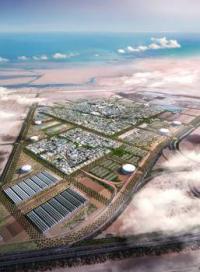Eco-cities have been promoted as the way of the future – sustainable urban zones designed to minimise human impact on the environment.
The general idea is to use less energy, water and food and produce less waste and pollution.
Internationally work has commenced on two such cities – the Tianjin project in China and Masdar City in Abu Dhabi. The hope is that lessons from these models can soon be applied to new and existing cities.
Why? Because for the first time ever, over 50% of the world’s population now lives in urban areas, and this figure is set to increase.
By 2030 it’s predicted that nearly 4 billion people – 80% of the world’s urban dwellers – will live in cities in the developing world. This is why they are leading the way in creating the world’s first eco-cities.
The Sino-Singapore Tianjin Eco-City project is expected to house 350,000 people and cover 30 sq km. The plan is to develop it over the next 10-15 years with the first 3 sq km to be completed in 2013.
The goal is to have targets and restrictions on everything from using non-traditional water sources and renewable energy to green transport and self-sufficient jobs.
It’s also purposely built on a wasteland so it doesn’t spoil any wildlife or food-growing areas.
China initially had an ambitious plan to build up to ten eco-cities. The first ever was supposed to be Dongtan – a city for 500,000 people across the Yangtze River from Shanghai.
The first part was due to open in time for this year’s Shanghai Expo, and include the regular features of non-petrol cars, self-sufficient water and energy, comprehensive recycling and zero-energy building principles.
But development has stalled for unknown reasons, although many believe the project may still have legs in some shape or form.
Instead China is focussing on Tianjin and ‘greening’ its existing cities.
What sets Tianjin apart from Dongtan is that it is business rather than government driven. The Singapore business group who owns 50% of the venture expects to make a profit, as does the Chinese group who owns the other 50%.
In contrast, the other major eco-city underway – Masdar City in oil-rich Abu Dhabi – is entirely government-funded (Masdar means ‘the source’ in Arabic).
Abu Dhabi’s intention is to create the world’s first zero-carbon, zero-waste city fuelled entirely by renewable energy such as sunlight and wind.
It also plans to hosts the world’s largest hydrogen power plant and will be the headquarters of the International Renewable Energy Agency.
The goal is to become not only a working model for eco-living, but also a global research hub for renewable energy and clean technology, and an international centre where companies ‘converge to address man’s greatest challenges’.
By completion in 2014, it’s expected to accommodate 50,000 people and 1,500 businesses.
Cars will be banned and people will move around by public transport, meaning narrower streets. This combined with a huge wall will allow the inner city to remain cooler by being sheltered from the sun and desert winds.
Critics suggest Masdar City is a distraction from the real issue – that Abu Dhabi’s carbon footprint is one of the worst in the world. They say the US$22 billion would be far better spent ‘greening’ Abu Dhabi itself.
But to the government, attracting foreign investment into the country as a new eco-city hub seems far more appealing.
Plus, Masdar City has some serious academic backing from the likes of America’s MIT and Japan’s Tokyo Institute of Research.
So are eco-cities really going to be the way of the future?
The successful completion of an effective working example will be the determining factor. But so will our ability to learn from these city ‘laboratories’ and apply them to the belching urban beasts we currently inhabit.
http://www.thecasualtruth.com/story/creating-world%E2%80%99s-first-eco-cities

